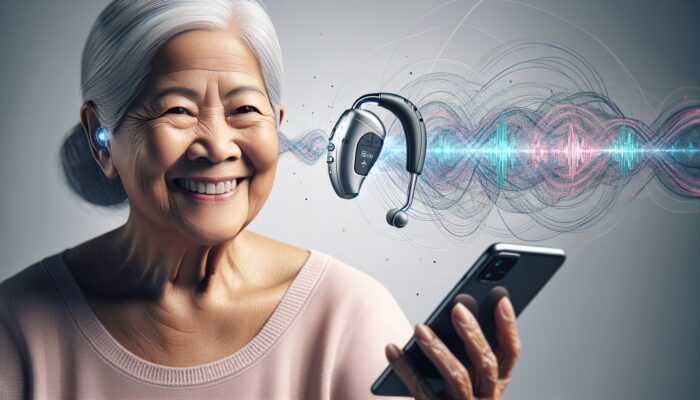Last Updated on 01/07/2025 by Admin
Discover the Fascinating Origins of Hearing Aids
Unveiling the First Hearing Devices: Ear Trumpets

The remarkable journey of hearing aids commenced with the creation of ear trumpets, which were innovative devices designed to capture and amplify sound waves directly into the ear. These early aids were crafted from various materials, including metal, wood, and even paper, molded into a funnel or cone shape to effectively gather sounds from the surrounding environment. The historical significance of these devices is intriguing; during the 17th and 18th centuries, individuals with hearing impairments often faced social marginalization. The introduction of the ear trumpet symbolized a pivotal move towards greater inclusion and accessibility for those affected by hearing loss.
While the ear trumpet served as a functional tool, its awkward design posed challenges for users. Proper positioning was essential for effectively capturing sound, often leaving users struggling to hear in bustling, noisy environments. This limitation ignited a wave of innovation aimed at enhancing the effectiveness and practicality of such devices, paving the way for future advancements in hearing technology.
The 19th century witnessed a surge in the popularity of ear trumpets, particularly across Europe and North America. Inventors began experimenting with diverse materials and designs, resulting in an array of trumpet shapes tailored to the varying needs of users. Interestingly, as these devices gained acceptance in public spaces, the social stigma associated with hearing loss began to diminish. Despite these advancements, early hearing aids still struggled to provide a holistic solution for all types of hearing loss, leaving users with ongoing challenges.
Tracing the Evolution of Ear Trumpets
The evolution of ear trumpets stands as a testament to human creativity, showcasing gradual improvements in both design and functionality. Initially, these devices were basic cones that simply focused sound waves, but over time, they evolved into more elaborate shapes—such as bell-shaped or spiral designs. These enhancements were not only visually appealing; they significantly increased sound collection efficiency, making it easier for users to hear conversations and ambient sounds in various settings.
The materials used in crafting ear trumpets also underwent remarkable advancements. Early models were often constructed from heavy metals or woods, making them cumbersome for everyday use. As society began to embrace modern materials like plastics and lighter metals, the design of ear trumpets became more user-friendly and portable. This transformation not only improved user comfort but also facilitated greater mobility, allowing users to carry their aids without feeling encumbered.
Cultural attitudes towards ear trumpets shifted as these devices gained popularity. The stigma associated with hearing loss began to wane, especially as notable artists and intellectuals began to use them openly. This growing acceptance laid the groundwork for further advancements in hearing assistance technology, fostering a more inclusive society for individuals with hearing challenges.
Identifying the Limitations and Challenges of Early Hearing Aids
Despite their practicality, early hearing aids encountered numerous limitations that impeded widespread adoption. The bulkiness of ear trumpets often resulted in social stigma, as users frequently felt self-conscious about their appearance. This concern was exacerbated by the fact that many designs were not easily concealable, drawing attention to the user’s hearing impairment, which could discourage them from using these devices in public.
Moreover, the amplification capabilities of these devices were limited, often resulting in distorted sounds or insufficient amplification of softer voices. Users frequently faced difficulties in crowded or noisy environments, where background noise could easily overwhelm the faint sounds they were trying to discern. This lack of adaptability led many potential users to forgo hearing aids altogether, choosing instead to isolate themselves from social interactions.
The combination of size, social stigma, and inadequate sound amplification presented significant hurdles in the early days of hearing aids. These challenges underscored the pressing need for innovation and development in the field, ultimately setting the stage for the emergence of electronic hearing aids in the 20th century.
Revolutionary Developments in Electronic Hearing Aids

The Groundbreaking Invention of the Carbon Hearing Aid
The early 20th century heralded a transformative era in the realm of hearing aids with the advent of the carbon hearing aid. This pivotal technological advancement was propelled by the emergence of new electronic components, enabling inventors to transcend the limitations of traditional ear trumpets. The carbon hearing aid utilized carbon microphones to convert sound waves into electrical signals, amplifying them before transmitting them directly into the user’s ear.
The introduction of this device marked a revolutionary shift in how individuals with hearing impairments engaged with the world around them. For the first time, users enjoyed a significant enhancement in sound quality and amplification. The carbon hearing aid transformed the auditory experience, allowing users to participate more fully in conversations and reducing the social isolation that often accompanied hearing loss.
However, despite these advancements, the carbon hearing aids were not without their challenges. They were frequently bulky and required substantial power sources, which could sometimes limit their portability. Nonetheless, the introduction of this device represented a monumental leap forward in auditory technology, sparking further innovations in the years to come.
Advancements through Vacuum Tube Technology
The 1930s marked the introduction of vacuum tube technology into hearing aids, representing another revolutionary advancement in sound amplification. Vacuum tube hearing aids were significantly smaller and more powerful than their carbon predecessors, providing enhanced sound quality and greater flexibility for users. These devices employed vacuum tubes to amplify sound signals, resulting in a clearer and more reliable auditory experience.
One of the notable strengths of vacuum tube technology was its ability to enhance sound fidelity, enabling users to access a broader range of frequencies. This improvement was particularly beneficial for individuals with partial hearing loss, as it allowed them to detect sounds that were previously inaudible. The heightened sound quality contributed to a greater societal acceptance of hearing aids, as users felt more comfortable engaging in social situations.
However, it is important to recognize that vacuum tube hearing aids still retained a relatively bulky design and required regular maintenance, which made them less than ideal for everyday use. The technology was also power-intensive, necessitating frequent battery replacements. Despite these challenges, the introduction of vacuum tube technology set the foundation for future innovations that would address these issues.
The Impact of Early Adoption of Electronic Hearing Aids

As electronic hearing aids began to gain traction, their societal impact became increasingly apparent. Technological advancements allowed individuals with hearing impairments to reconnect with their surroundings, improving their overall quality of life. For many, the ability to hear clearly transformed their social interactions, enabling them to participate in conversations and activities they had previously avoided due to their hearing loss.
The proliferation of electronic hearing aids contributed to a broader cultural shift regarding hearing loss. The stigma surrounding the use of these devices began to dissipate, paving the way for increased acceptance and understanding. This transformation was not just a change in perception; it underscored the importance of accessibility and inclusivity for all individuals, regardless of their hearing abilities.
Another critical aspect of early adoption was the role of healthcare professionals in advocating for these devices. Audiologists and hearing specialists played an instrumental role in educating patients about the benefits of electronic hearing aids, encouraging wider acceptance. Their efforts helped demystify the use of hearing aids, bridging the gap between users and non-users and fostering a supportive community.
Transition to Transistor-Based Hearing Aids
The introduction of transistor technology in the 1950s represented a significant evolution in hearing aids. Transistor-based hearing aids were not only smaller and more portable but also offered improved reliability compared to earlier models. This miniaturization made it easier for users to wear their devices without feeling self-conscious, promoting broader acceptance and integration of hearing aids into daily life.
The sound quality of transistor hearing aids saw remarkable enhancements as well. These devices provided superior amplification and clarity, allowing users to enjoy a more natural listening experience. The technological progress enabled users to engage in conversations even in challenging auditory environments, such as bustling restaurants or crowded public spaces. This was a pivotal moment for many individuals, enabling them to reclaim their social lives and interact more freely.
Moreover, the affordability of transistor technology meant that hearing aids became accessible to a wider audience. Manufacturers could produce these devices at lower costs, making them available to individuals who may have previously viewed hearing aids as financially out of reach. This accessibility played a crucial role in increasing the number of people benefiting from hearing aids worldwide, further altering societal perceptions of hearing loss.
The Transistor Revolution in Hearing Aids
The Miniaturization of Hearing Aids
The transistor revolution fundamentally reshaped the design and functionality of hearing aids, particularly regarding their size. This period marked a shift towards miniaturization, allowing devices to become significantly smaller and more discreet. Users no longer felt encumbered by bulky equipment, which had previously served as a psychological barrier. The transition to compact hearing aids enabled individuals to incorporate their devices seamlessly into their daily lives, fostering a sense of normalcy and acceptance of their hearing aids.
The advantages of miniaturization extended beyond mere aesthetics. Smaller devices frequently translated to improved comfort for users, enabling them to wear hearing aids for extended periods without discomfort. This increased wearability was crucial in ensuring users could benefit from their devices throughout the day, ultimately enhancing their auditory experience and encouraging consistent use.
The trend toward miniaturization also inspired a wave of creativity among manufacturers. Innovative designs emerged, with hearing aids crafted in various shapes and colors to appeal to diverse user preferences. This customization aspect not only improved user satisfaction but also encouraged greater acceptance among younger generations, who often prioritize style and appearance in their choices.
Experience the Enhanced Sound Quality of Transistor Hearing Aids
One of the standout features of transistor-based hearing aids was the remarkable improvement in sound quality. The transition from vacuum tubes to transistors facilitated more precise sound amplification and processing. Users benefitted from a more natural auditory environment, allowing them to distinguish different tones and frequencies more effectively, which significantly enhanced their overall listening experience.
The improved sound quality had a profound impact on users’ social interactions. Individuals could engage in conversations without straining to hear, fostering more meaningful connections with friends and family. The clarity provided by transistor technology enabled users to enjoy music, television, and other auditory experiences in ways they had never imagined, further enriching their lives.
Moreover, this enhanced sound quality played a critical role in the rehabilitation of individuals with hearing impairments. Audiologists and speech therapists observed that users were better able to comprehend speech and respond more effectively, which was especially important for those undergoing auditory training or rehabilitation. The advancements in sound processing heralded a new era of support for individuals with hearing loss.
Improving Accessibility and Affordability of Hearing Aids
The democratization of hearing aids through transistor technology significantly enhanced their accessibility and affordability. As manufacturers produced smaller and more reliable devices, economies of scale allowed for lower prices. This shift made hearing aids attainable for a broader audience, including individuals from various socioeconomic backgrounds, ultimately fostering a more inclusive society.
The increased affordability of transistor hearing aids was particularly impactful in developing nations, where access to healthcare and assistive devices can be limited. Lower-cost options opened new avenues for individuals who would otherwise remain isolated due to their hearing impairments. Organizations and non-profits began recognizing the urgent need for affordable hearing solutions, leading to initiatives aimed at providing these essential devices to underserved populations.
Additionally, the availability of various models and price points enabled users to select devices that catered to their specific needs and budgets. This variety empowered individuals to take charge of their hearing health, fostering a sense of agency that had previously been lacking in the realm of hearing aids.
Enhanced Battery Life in Hearing Aids
The transition to transistor technology not only revolutionized the design and functionality of hearing aids but also significantly improved their battery life. Older hearing aids that relied on vacuum tubes often had limited battery life, necessitating frequent changes and causing inconvenience for users. In contrast, transistor-based hearing aids were more energy-efficient, allowing users to enjoy longer periods of use without the hassle of constant battery replacements.
This enhancement in battery life was crucial for promoting consistent device use. Users no longer had to worry about their devices dying at inconvenient moments, which could lead to frustration and diminished trust in their hearing aids. The reliability of longer-lasting batteries encouraged greater user commitment, enabling individuals to wear their devices throughout the day without fear of interruption.
Moreover, advancements in battery technology contributed to the environmental sustainability of hearing aids. As manufacturers prioritized energy-efficient designs, the demand for disposable batteries decreased, resulting in a positive impact on the environment. Users could feel good about their choices, knowing that their devices contributed to a reduced ecological footprint while still providing essential auditory support.
Embracing Digital Hearing Aids
Transitioning to Cutting-Edge Digital Technology
The late 20th century marked a monumental turning point in the history of hearing aids with the shift from analog to digital technology. Digital hearing aids revolutionized sound processing capabilities, enabling unprecedented advancements in how sound was amplified and delivered to users. By converting sound waves into digital signals, these devices could analyze and manipulate sound with remarkable precision, enhancing the overall auditory experience.
One of the most significant benefits of digital technology was the ability to customize sound settings for individual users. These devices could be programmed to filter out background noise, enhance speech recognition, and adjust to various auditory environments. This level of adaptability proved to be a game-changer for users, allowing them to engage more fully in conversations and social settings without feeling overwhelmed by external noise.
As digital technology advanced, users also experienced significant improvements in sound fidelity. The algorithms utilized in these devices enabled them to process complex auditory environments more effectively, ensuring that users could discern speech amidst background noise. This technological breakthrough transformed the user experience, prompting a broader acceptance of hearing aids in diverse social contexts.
Customizable Features for Enhanced User Control
The introduction of programmable features in digital hearing aids marked a significant leap forward in user control and personalization. For the first time, users could tailor their devices to meet their unique hearing needs and preferences. Audiologists began utilizing computerized fittings to adjust settings based on individual audiograms, ensuring that each user received a customized auditory experience.
This personalization extended beyond basic adjustments, with many digital hearing aids offering multiple programs for different environments. Users could effortlessly switch between settings for quiet conversations, noisy gatherings, or outdoor activities with the simple press of a button. This flexibility allowed individuals to navigate various social situations with confidence, significantly enhancing their quality of life.
In addition to customizable sound profiles, many digital hearing aids began incorporating advanced features like feedback cancellation, which eliminated annoying whistling sounds that often occurred with older models. These innovations not only improved user satisfaction but also fostered greater confidence in wearing hearing aids, as users could now enjoy a seamless auditory experience.
Enhancing the User Experience with Digital Hearing Aids
The digital era brought substantial enhancements to the overall user experience, setting a new standard for auditory devices. Noise reduction technologies became commonplace, enabling users to filter out unwanted sounds while focusing on conversations or important audio cues. This capability proved particularly beneficial in crowded environments, where background noise could frequently drown out essential sounds, making communication challenging.
Directional microphones emerged as another groundbreaking feature in many digital hearing aids. These microphones could identify the source of sounds and prioritize them based on their direction. Consequently, users could engage in conversations more effortlessly, as their devices would amplify sounds coming from in front of them while minimizing noise from the sides and behind. This technology transformed how individuals interacted with their surroundings, making social engagements more enjoyable and less stressful.
The enhanced user experience was not limited to sound quality; it also encompassed improved comfort and design. Digital hearing aids often featured ergonomic designs that facilitated extended wear without discomfort. Furthermore, advancements in materials led to devices that were lighter and less intrusive, thereby promoting user acceptance and satisfaction.
Seamless Connectivity and Integration of Hearing Aids
As technology progressed, digital hearing aids began to incorporate seamless connectivity with smartphones and other devices. This integration allowed users to control their hearing aids through mobile apps, simplifying adjustments, program changes, and battery life monitoring. The convenience of app-based control empowered users to take charge of their auditory experiences like never before.
Moreover, the ability to stream audio directly from smartphones or other devices transformed how users interacted with media. Whether listening to music or taking phone calls, individuals could enjoy a more immersive auditory experience without the need for additional accessories. This level of connectivity not only enhanced the functionality of hearing aids but also made them more appealing to younger users accustomed to technology-rich environments.
The integration of digital hearing aids with smart home devices further extended their capabilities. Users could connect their hearing aids to home assistants, enabling voice-activated control of various settings. This innovation exemplified the direction in which hearing aid technology was headed: towards greater integration with the increasingly interconnected world around us, enriching the user experience.
Advanced Signal Processing for Optimal Sound Quality
The implementation of advanced algorithms in digital hearing aids has had a profound impact on both sound quality and user experience. These sophisticated signal processing techniques allow devices to analyze sound in real-time, dynamically adjusting amplification levels based on the user’s environment. This capability ensures that users experience the highest possible sound quality, regardless of their surroundings.
Advanced signal processing also plays a crucial role in managing hearing aid feedback. Feedback, often characterized by bothersome whistling sounds, can pose a significant issue for users. Modern algorithms can swiftly detect and mitigate feedback, allowing users to enjoy clear sound without interruption. This technological advancement has been pivotal in increasing user confidence and satisfaction with their hearing aids.
Furthermore, the incorporation of machine learning capabilities into hearing aids is paving the way for even more personalized experiences. Devices can learn from users’ preferences and behaviors, adapting their settings over time to better meet individual needs. This level of personalization not only enhances the user experience but also promotes a more natural integration of hearing aids into daily life.
Exploring Modern Innovations in Hearing Aids
Revolutionizing Hearing Aids with Wireless Connectivity
Modern hearing aids are increasingly equipped with wireless connectivity features, allowing for seamless interaction with a wide array of devices. This capability has opened up new avenues for users, facilitating audio streaming directly from smartphones, televisions, and other multimedia sources. The result is a richer auditory experience that enhances both entertainment and communication for individuals with hearing impairments.
Wireless connectivity also enables users to receive phone calls through their hearing aids, eliminating the need for additional accessories. This convenience has transformed how individuals communicate, allowing them to engage in conversations without the hassle of holding a phone to their ears. The integration of hearing aids with smartphones has made it easier for users to stay connected with friends, family, and colleagues, significantly improving their overall quality of life.
Moreover, the ability to connect hearing aids to smart devices has led to innovative applications that enhance user control. Mobile apps provide users with the ability to customize settings in real-time, monitor battery life, and even access customer support resources. This level of connectivity empowers individuals to take charge of their hearing health like never before, fostering a sense of independence.
The Game-Changing Impact of Rechargeable Batteries
The development of rechargeable batteries has been a game-changer in the world of hearing aids. Gone are the days of frequent battery replacements, which could be both inconvenient and costly. Modern rechargeable hearing aids offer users the convenience of simply placing their devices on a charging dock at the end of the day, ensuring they are fully powered for the next day’s activities.
Rechargeable batteries not only enhance convenience but also contribute to environmental sustainability. With fewer disposable batteries being used, users can feel good about their eco-friendly choices. This shift aligns with broader societal trends towards sustainability and responsibility, making rechargeable hearing aids an appealing option for environmentally-conscious consumers.
Additionally, the advent of rapid charging technology means that users can enjoy longer battery life with shorter charging times. This is particularly beneficial for those who may forget to charge their devices overnight or for users who need a quick power boost before heading out. The increased reliability of rechargeable batteries has further solidified their place in modern hearing aid designs.
Smartphone Integration for Enhanced User Control
The integration of hearing aids with smartphones has revolutionized how users interact with their devices. Mobile apps have become essential tools for managing hearing aids, offering users unprecedented control over their settings and features. This level of customization allows individuals to tailor their auditory experiences based on their specific preferences and needs.
Users can adjust volume levels, switch programs, and even access remote support from audiologists through their smartphone apps. This convenience fosters a sense of independence and empowerment, as individuals can manage their hearing health more effectively. Moreover, the app-based approach provides users with valuable insights into their hearing habits, enabling them to make informed decisions about their auditory health.
Beyond basic management features, many apps offer advanced functionalities such as soundscape personalization, allowing users to create specific auditory environments tailored to their preferences. This level of customization enhances the overall user experience, making hearing aids more adaptable to varying social situations and personal needs.
Looking Towards the Future of Hearing Aids
The Role of Artificial Intelligence in Hearing Aid Evolution
The integration of artificial intelligence (AI) into hearing aids promises to revolutionize the future of auditory technology. AI has the potential to enhance sound processing and personalization, allowing devices to learn and adapt to individual users’ preferences and behaviors over time. This level of sophistication could lead to previously unimaginable advancements in the quality of life for individuals with hearing impairments.
One of the most exciting prospects of AI in hearing aids is its ability to analyze complex auditory environments. Future devices may be able to identify specific sounds, such as speech, and prioritize them while filtering out irrelevant background noise. This capability would significantly improve users’ experiences in challenging auditory settings, such as crowded events or noisy public spaces.
Additionally, AI could facilitate real-time adjustments to hearing aid settings based on user feedback and preferences. Imagine a hearing aid that learns your favorite settings for different environments—whether you’re at home, in a restaurant, or attending a concert—automatically adjusting itself to provide optimal sound quality. This personalized approach would not only enhance user satisfaction but also foster greater trust in hearing aid technology.
Exploring the Potential of Implantable Devices
The future of hearing aids may also shift towards implantable devices, offering a more permanent and discreet solution for individuals with hearing loss. These innovations could potentially provide a seamless alternative to traditional external hearing aids, significantly improving comfort and usability. Implantable devices could be designed to work directly with the auditory nerve, bypassing damaged structures within the ear.
Such advancements could be particularly beneficial for individuals with severe or profound hearing loss who have found traditional hearing aids ineffective. The potential for implantable hearing devices to deliver clear, natural sound may dramatically enhance the quality of life for those affected by hearing impairments.
As research and technology in this area continue to evolve, we might witness the development of minimally invasive procedures for implantation, reducing recovery times and complications. This shift toward implantable options could not only enhance auditory experiences but also reshape societal perceptions of hearing loss and assistive devices.
The Future of Wireless Connectivity in Hearing Aids
Advancements in wireless technology will continue to enhance hearing aids’ ability to connect seamlessly with smartphones and other devices. Future innovations may allow for even greater integration with smart home systems, enabling users to control their entire auditory environment through a single interface. Imagine a world where your hearing aids adjust automatically based on your surroundings, optimizing sound quality without any manual intervention.
Additionally, improved wireless connectivity could lead to collaborative features, allowing users to share settings and experiences with others. This sharing capability could further enhance community support for individuals with hearing loss, fostering a sense of connection and understanding among users.
As the world becomes increasingly interconnected, the role of hearing aids as a vital tool for communication and social engagement will only grow. The future promises exciting possibilities that will enhance user experiences and integration across various aspects of life.
Advancements in Personalization: A Bright Future for Hearing Aids
The future of hearing aids is poised to deliver unprecedented advancements in personalization, empowering users to create tailored auditory experiences like never before. As technology evolves, the capacity of hearing aids to adapt to individual needs will continue to expand. From customizable sound profiles to user-driven adjustments, the next generation of hearing aids will offer a level of personalization that significantly enhances user satisfaction.
Imagine hearing aids that can analyze your listening habits and preferences over time, automatically adjusting settings based on your environment and activities. This level of personalization will not only enhance user comfort but also foster greater confidence in using hearing aids. The combination of machine learning and user feedback will drive this evolution, promoting a seamless integration of hearing aids into daily life.
Furthermore, advancements in teleaudiology will enable remote support and adjustments from audiologists, allowing users to receive tailored care without the need for frequent in-person visits. This accessibility will empower users to maintain their hearing health more effectively, facilitating optimal auditory experiences.
The future of hearing aids holds tremendous promise, with innovations in AI, implantable devices, wireless connectivity, and personalization set to transform the landscape. As technology continues to evolve, users can look forward to a world where hearing aids enhance not only their auditory experiences but also their overall quality of life.
Frequently Asked Questions About Hearing Aids
What are hearing aids and how do they function?
Hearing aids are electronic devices engineered to amplify sound for individuals with hearing loss, significantly improving their ability to engage in communication and interact with their environments. They operate by capturing sound through a microphone, amplifying it via an internal amplifier, and delivering it to the user’s ear through a speaker. Modern hearing aids often incorporate advanced technology to enhance sound quality and processing capabilities.
What types of hearing aids are available?
Numerous types of hearing aids exist, including behind-the-ear (BTE), in-the-ear (ITE), and completely-in-canal (CIC) models. Each type offers various features and amplification levels that cater to different user needs and preferences.
How do I select the right hearing aid for myself?
Choosing the right hearing aid involves evaluating your hearing loss severity, lifestyle requirements, budget, and personal preferences. Consulting a qualified audiologist can assist you in identifying the best option tailored to your specific needs.
Are hearing aids covered by insurance plans?
Coverage for hearing aids varies between insurance providers, with some plans covering part or all of the associated costs. It’s crucial to verify the specifics with your insurance provider to understand your coverage options.
How frequently should hearing aids be serviced?
Hearing aids should ideally be serviced at least once a year for maintenance, cleaning, and adjustments. Regular check-ups ensure optimal performance and extend the lifespan of the devices.
Can I use hearing aids in conjunction with my smartphone?
Many modern hearing aids come equipped with wireless connectivity features, allowing users to connect them to smartphones for streaming audio, adjusting settings, and managing features through dedicated applications.
What should I do if my hearing aid malfunctions?
If your hearing aid is not working properly, start by checking the battery, cleaning the device, and ensuring it is fitted correctly. Should issues persist, consulting an audiologist for professional assistance is advisable.
What is the typical lifespan of a hearing aid battery?
The longevity of a hearing aid battery depends on usage and battery type. Typically, disposable batteries last between 3 to 7 days, while rechargeable models can sustain power for several days on a single charge.
Are there any side effects associated with using hearing aids?
While hearing aids are generally safe, some users may experience discomfort or minor ear irritation. Proper fitting is essential, and consulting a professional can help address any issues that arise.
Explore our world on X!
The post Hearing Aids Explained: A Brief History and Overview appeared first on The Microsuction Ear Wax Removal Network.




















